Kaitlyn Gaynor
Other projects
29 Nov 2016
Wildlife Recovery Amid Human Expansion in Mozambique’s Gorongosa National Park II
This study examines the effects of human settlement and activity on ungulate behavior and distribution in a restored protected area in Mozambique.

Female nyala.
After losing 90% of its large mammal populations during Mozambique’s civil war, Gorongosa National Park today serves as an emblem of ecological rebirth. Extensive wildlife reintroductions and renewed investment in park management have changed the trajectory of an area that ranks among the most biodiverse in Africa and traditionally supported some of the world’s highest concentrations of large mammals. However, this wildlife restoration is not without its challenges: Gorongosa is currently experiencing rapid human development as tourism infrastructure grows and settlements expand along park borders, threatening the park’s impressive recovery. Understanding the interactions between growing human and wildlife populations is critical for maintaining Gorongosa’s restoration while planning for the future of this dynamic system.
To better understand the influence of expanding human activity on Gorongosa’s recovering wildlife populations, I will focus on an understudied but important aspect of human-wildlife interactions: wildlife responses to perceived anthropogenic risk. Animals may be fearful and wary of human activity, and engage in costly anti-predator responses with cascading consequences for individuals, populations, and communities. I will examine whether three keystone ungulate species avoid human activity (risk avoidance hypothesis) or adapt to human presence (habituation hypothesis).
To evaluate these hypotheses, I will measure the type, location, and level of human activity across the park and examine how human activity affects spatial variation in anti-predator behavior. I will measure anti-predator behavior at multiple scales, including reactive individual behaviors (through direct observation of flight, vigilance, and grouping) and proactive changes in spatiotemporal distribution (through camera trapping, pellet counts, and visual surveys).
As one of the first researchers in Gorongosa, I will identify potential anthropogenic threats to wildlife recovery and elucidate human activities that may be compatible with conservation. These findings will shed light on how humans and wildlife may be able to coexist as they come into greater contact, in Gorongosa and beyond.